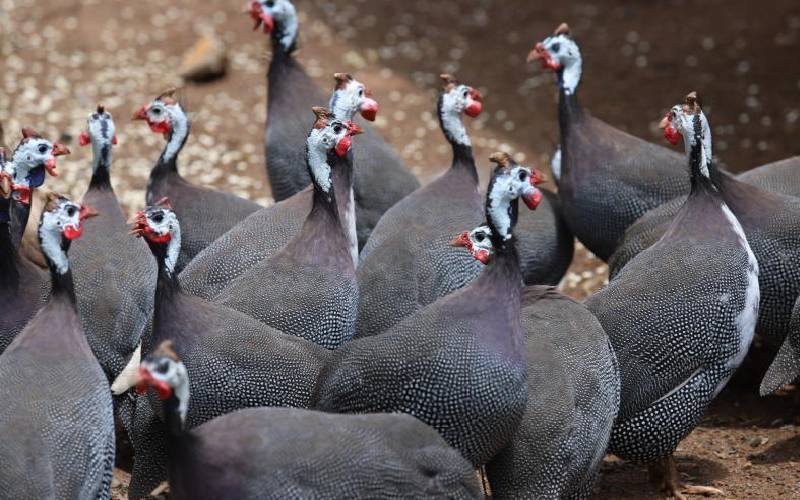How to handle Fowl typhoid in your birds

Fowl typhoid is caused by the bacterium Salmonella gallinarum with an incubation period of four-seven days.
It mostly affects chicken but also mature birds like guinea fowls, sparrows and ostriches, among others.
The chicken, however, are the natural hosts with an Chicken are the natural hosts.
Common signs of Fowl typhoid
The clinical signs in chicks with Fowl typhoid include moribund and dead birds in the incubator or shortly after hatching if the chicks are hatched from infected eggs.
The birds may manifest depression, somnolence, lack of appetite, huddling together, droopy wings, dehydration, laboured breathing, greenish-yellow diarrhoea with mucus, dehydration, ruffled feathers, weakness, and adherence of feces to the vent.
In some situations, Fowl typhoid may not be observed until five to 10 days after hatching. The highest mortality usually occurs in birds of two to three weeks old.
Survivors may be greatly reduced in weight and poorly feathered, and may not mature into well-developed laying or breeding birds.
Flocks that have experienced a severe outbreak will have a higher percentage of carriers at maturity. Other signs include blindness, swelling of the joints of the wings, and feet.
Non-specific clinical signs, including a decline in feed consumption, a droopy appearance, or ruffled feathers and pale and shrunken combs may be observed. Other signs, including decreased egg production, fertility, and hatchability, may also be observed depending on the severity of the infection.
Death can occur within four days of exposure but usually occurs after five to 10 days. An increase in body temperature may also occur as a result of Fowl typhoid.
How do birds get Fowl typhoid?
Through the egg from infected birds, cannibalism, contaminated feed, water, and litter, bacteria is excreted through the faeces of infected birds and persist in faeces for at least a month.
Chicken can get Fowl typhoid from carriers – infected birds, wild birds and insects such as red mites.
Infection can also be spread by fomites that are trucks, workers, and equipment.
Prevention
Fowl typhoid can be eradicated by the application of basic management procedures or eradication programmes. One of the basic requirements is to establish breeding flocks free of Salmonella gallinarum and to hatch and rear progeny under conditions that will preclude direct or indirect contact with infected chickens.
Since egg transmission plays an important role in the spread of this disease, only eggs from flocks known to be free of Fowl typhoid should be introduced into hatcheries.
Destroying positive breeders is also an important step.
Use chlorine in water for chicken.
Vaccination is an effective method for preventing outbreaks.
Treatment
Every effort should be made to eradicate Fowl typhoid and treatment should be the last option. Various antibiotics are effective in reducing mortality from Fowl typhoid. However, no drug or combination of drugs is capable of eliminating infection from infected flocks.
Most studies have indicated that despite treatment options, a significant number of infected birds can remain among the survivors and become carriers. Care must be taken to follow the directions given by the manufacturer concerning the route of administration, dosage, duration of treatment, and the withdrawal period for each antibiotic before use.
Want to get latest farming tips and videos?
Join Us
Share this article on social
 The Standard Group Plc is a multi-media organization
with investments in media platforms spanning newspaper print operations,
television, radio broadcasting, digital and online services. The Standard Group
is recognized as a leading multi-media house in Kenya with a key influence in
matters of national and international interest.
The Standard Group Plc is a multi-media organization
with investments in media platforms spanning newspaper print operations,
television, radio broadcasting, digital and online services. The Standard Group
is recognized as a leading multi-media house in Kenya with a key influence in
matters of national and international interest.
 The Standard Group Plc is a multi-media organization
with investments in media platforms spanning newspaper print operations,
television, radio broadcasting, digital and online services. The Standard Group
is recognized as a leading multi-media house in Kenya with a key influence in
matters of national and international interest.
The Standard Group Plc is a multi-media organization
with investments in media platforms spanning newspaper print operations,
television, radio broadcasting, digital and online services. The Standard Group
is recognized as a leading multi-media house in Kenya with a key influence in
matters of national and international interest.







